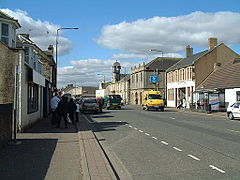Polkemmet
| Whitburn | |
|---|---|
 Whitburn, looking west towards the town centre |
|
| Whitburn shown within West Lothian | |
| Population | 10,527 (2011 Census) |
| OS grid reference | NS945645 |
| Council area | |
| Lieutenancy area | |
| Country | Scotland |
| Sovereign state | United Kingdom |
| Post town | BATHGATE |
| Postcode district | EH47 |
| Dialling code | 01501 |
| Police | Scottish |
| Fire | Scottish |
| Ambulance | Scottish |
| EU Parliament | Scotland |
| UK Parliament | |
| Scottish Parliament | |
Whitburn (Scottish Gaelic: Am Fionn Allt, meaning "The White Burn") is a small town in West Lothian, Scotland, halfway between Scotlands's two largest cities, about 27 miles (43 km) east of Glasgow and 23 miles (37 km) west of Edinburgh. The nearest major towns are Bathgate, 4 miles (6 km) and Livingston, 7 miles (11 km).
The town was once dominated by Polkemmet Colliery – a large coal mine – but this was closed as a result of damage by underground flooding during the 1984-85 miners' strike and never re-opened. The colliery buildings have gone, and the coal bings that once were prominent have now been removed. Work to dismantle Bing No 3, the infamous burning bing, started in August 2006 and was completed by February 2008. The last major outbreak of burning occurred in 1998.
The town's population was boosted by the 1960s Glasgow overflow. The town's Murraysgate and surrounding areas north-west of the cross were established to deal with the overflow.
The local secondary school is Whitburn Academy. It is a state run non-denominational secondary school serving pupils aged 11 to 18. Its catchment area is the town of Whitburn and the surrounding villages of Fauldhouse, Longridge, East Whitburn, Stoneyburn, and Greenrigg. There are approximately 1,000 pupils at the school.
The town's primary schools include Whitdale, Polkemmet, Croftmalloch, St Joseph's and Burnhouse.
Whitburn has a King George's Field in memory of King George V which was opened in 1955 by Queen Elizabeth II.
...
Wikipedia

